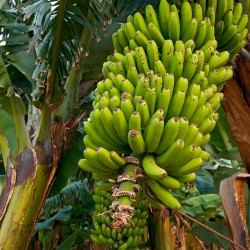Seeds Gallery Com,
5/
5
<!DOCTYPE html>
<html>
<head>
<meta http-equiv="Content-Type" content="text/html; charset=UTF-8" />
</head>
<body>
<h2><span style="text-decoration: underline;"><strong><em>SEMENTES DE BANANEIRA MUSA NAGENSIUM -20C</em></strong></span></h2>
<h3><span style="color: #ff0000;"><strong>Preço para o pacote de 3 sementes.</strong></span></h3>
<p>Musa nagensium is a beautiful, slender banana with a striking dark purple-red to almost black pseudo-stem which is very waxy.</p>
<p>The abaxial surface of the leaf has a dark red midrib and the lamina is so waxy that is nearly white.</p>
<p>The pseudo-stem may exceed 6 m high. Produces suckers. The leaf is up to 3 m long and blue-gray. The leaves are quite far from each other compared to other bananas from the Eumusa group, further adding to the slender appearance of the plant .</p>
<p>Inflorescence is pendulous. The bracts are oblong and lanceolate, the lower are 20-25 cm long and 10 cm wide, the top ones are 15-18 cm long, almost 8 cm wide, red outside, bright orange on the inside. Each with 18 to 20 flowers in two rows. The perianth is orange, 6 cm long, 1.3 cm wide, four-lobed, free petal ovate-lanceolate, more than 2.5 cm long, pointed.</p>
<p>The fruits are 13-15 cm long, petiolate, not recurved. The seeds are very big: nearly 1.3 cm long and 1 cm wide.</p>
<p><strong>Origin:</strong></p>
<p>India, Assam, Naga mountains</p>
<p><strong>Hardiness: </strong>-20 °C</p>
<p><strong>Soil:</strong></p>
<p>Rich and well drained</p>
<p><strong>Height:</strong></p>
<p>6 m</p>
<p><strong>Exposure:</strong></p>
<p>Sun</p>
<p><strong>Propagation:</strong></p>
<p>Seed</p>
<p>Suckers</p>
<p><strong>Germination</strong></p>
<p>Banana seeds are not easy to germinate, with germination taking weeks or months, but it is extremely rewarding to see them succeed.</p>
<p>Prepare the seeds by soaking in tepid, sterilised or distilled water. Using a very small amount of the saltpetre powder provided (no more than half a teaspoon per 3 litres of water) will help remove and residue from the seeds and may aide germination by removing residue from the seeds.</p>
<p>Soak the seeds for two days, using the saltpetre on the first day and switching to distilled/sterilised water only on the second day.</p>
<p>Sow seeds into sterilised compost, vermiculite or a coir/perlite mix.</p>
<p>Use a heated propagator or place the planted seeds in a warm airing cupboard, away from direct sunlight. A temperature of 30-35 Celsius is required.</p>
</body>
</html>
V 111 MN





